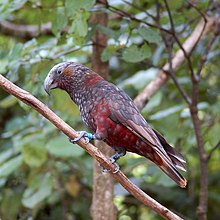Cocoa
| Cocoa | ||||||||||||
|---|---|---|---|---|---|---|---|---|---|---|---|---|

Kaka ( Nestor meridionalis ) |
||||||||||||
| Systematics | ||||||||||||
|
||||||||||||
| Scientific name | ||||||||||||
| Nestor meridionalis | ||||||||||||
| ( JF Gmelin , 1788) |

The kaka or forest parrot ( Nestor meridionalis ) is next to the kea ( Nestor notabilis ) the second still living species of Nestor parrots that occur in New Zealand . A third species, the thin-beaked nest , lived on the Norfolk Islands north and northeast of it until the mid-19th century .
features
The kaka is a parrot about 40 cm long. When it comes to the color of the plumage, shades of brown predominate on the neck, back, chest and on the top of the wings. The belly, the underside of the wings and a band between the neck and back are reddish, forehead and top of the head gray-white.
In the male, the beak is more curved than in the female.
distribution
It lives in the forests of New Zealand , in summer at heights of 450 to 850 m, in winter they occur from the flat coastal areas up to heights of 550 m, but are occasionally observed at heights of up to 1500 m as well as in gardens and parks. The subspecies N. meridionalis meridionalis occurs on the South Island, and N. meridionalis septentrionalis on the North Island . Both subspecies are threatened.
It is exterminated on the Chatham Islands .
Way of life
The kaka mainly lives in the forest, but it also visits bushes, parks and gardens. He needs trees as a seat. Kakas are extremely skilled climbers, although they can eat food hanging upside down from a branch, and use their beak as a third foot. Through the pollen in their head plumage, the birds also ensure that other plants are pollinated. Except during the breeding season, it lives together in smaller groups of up to ten specimens. Usually this bird is active at dawn, dusk and bright nights. Intraspecial aggression behavior (e.g. when there is a shortage of food) manifests itself in growling, screeching and / or a standing up of the wings combined with beaking. Otherwise, kakas can also whistle and trill melodically; regional populations of the species also have the ability to use different dialects.
nutrition
The cocoa feeds on fruits , seeds, buds , insects and their larvae and pupae , but also on flower nectar ( honeydew ) and shoots. An important part of its diet are the secretions of a scale insect living in the bark of trees and, when rearing the young, the seeds of the southern beech . In addition to the constriction of the habitat, this unusual food is also a reason for the threat to the species.
Breeding cycle
Not every year, but about every two to four years, the kakas mate, lay their eggs, brood for 21 days and then raise the 4–5 young (of which mostly only 2 survive). At first it was thought that this irregular incubation cycle would depend solely on the changing supply of energy-giving honeydew. However, researchers later discovered that it was primarily directly dependent on the fruit cycle of the southern beech . In the years when these trees develop a particularly large number of seeds and therefore a large supply of food for the kakas and their young is guaranteed, they also breed regularly.
Presumably, the birds are predominantly monogamous outside of the breeding season. During courtship, the male presents its glowing undersides of its wings, fans its tail feathers and moves its head vertically. By sitting posture and turning the tail feathers to the side, the female signals its readiness to mate, whereupon the male holds on to the partner's back with spread wings.
Kakas breed in tree hollows, rarely also in crevices or a kiwi burrow. The kaka uses selected tree hollows over several broods. The floor is covered with nibbled wood chips. Mostly the female breeds, only now and then the male, who brings food to the partner during this time, releases it.
At about 10 weeks the young are fully fledged and leave the nest.
use
The Māori hunt the parrots for their meat and use their red feathers to make cloaks for ceremonies.
Danger
The explosive multiplication of introduced European wasp species (now the common wasp ), which also live on the high-energy honeydew of scale insects and insects, has reduced the kaka's food supply to such an extent that their population is seriously endangered in the long term if it does not succeed to significantly reduce the population of common wasps.
The introduction of the weasel , which was not originally native to New Zealand, puts the cocoa in greater danger, as these predators regularly fall victim to many female cocoa that brood in tree hollows in one breeding cycle. In the Eglinton Valley National Park on New Zealand's South Island, where kakas were provided with transmitters, a study in 2008 using these data and calculations showed that kakas only have one chance of survival, even if the number of ermine traps continues to be the same as since the early 1990s is set up.
In Europe, kakas are only kept at the Wilhelma in Stuttgart .
Web links
- Nestor meridionalis - Parrot Network Working Group.
- Nestor meridionalis in the endangered Red List species the IUCN 2008. Posted by: BirdLife International, 2008. Accessed January 30 of 2009.
- Videos, photos and sound recordings of Nestor meridionalis in the Internet Bird Collection